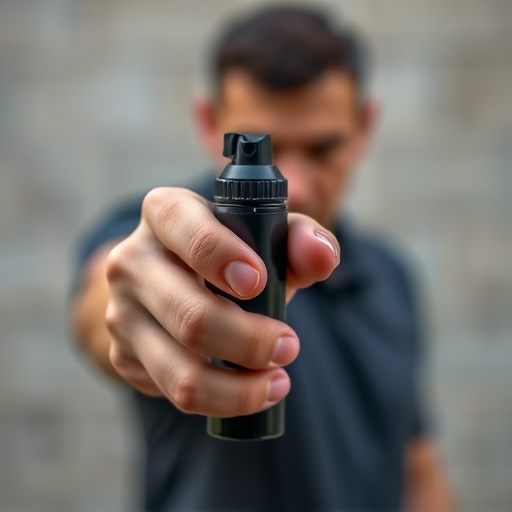Pepper spray equipment, a critical tool for law enforcement, includes a canister, trigger mechanism, and nozzle that deploy capsaicin solution. Modern devices often incorporate eye-washing procedures, offering immediate relief from severe eye irritation caused by pepper spray. The Pepper Spray Eye Washing Procedure involves a swift 15-minute irrigation with clean, lukewarm water, starting with safety assessments and proper training to minimize risks and long-term damage during high-pressure situations.
“In the field of law enforcement, effective control tools are paramount. One such tool, pepper spray, plays a crucial role in managing volatile situations. This article explores the intricate world of law enforcement pepper spray equipment and its vital component: the Pepper Spray Eye Washing Procedure. We’ll dissect different types of pepper spray gear, eye washing techniques for safe de-escalation, and essential safety precautions for officers. By understanding these aspects, we can enhance operational efficiency while prioritizing officer and public safety.”
- Understanding Pepper Spray Equipment: Types and Components
- The Role of Eye Washing in Pepper Spray Management
- Step-by-Step Guide: Implementing the Pepper Spray Eye Washing Procedure
- Safety Precautions and Best Practices for Law Enforcement Officers
Understanding Pepper Spray Equipment: Types and Components
Pepper spray equipment is a critical component of law enforcement tools, designed to control and subdue individuals during various security operations. Understanding its types and components is essential for effective deployment and safety procedures. These devices typically consist of several key parts: the canister, which houses the pepper spray solution; a trigger mechanism that releases the spray; and a nozzle or applicator to direct the spray towards the target.
The pepper spray itself is usually a concentrated solution containing capsaicin, the active ingredient responsible for the burning sensation it induces when in contact with eyes, skin, or respiratory system. Additionally, many modern pepper spray equipment incorporate eye-washing procedures as a safety measure. This involves including eye wash stations or bottles to help individuals affected by the spray to quickly and safely irrigate their eyes, reducing potential long-term damage.
The Role of Eye Washing in Pepper Spray Management
Eye washing plays a crucial role in managing pepper spray during law enforcement operations. When officers use pepper spray, it can cause severe eye irritation and even temporary blindness. The Pepper Spray Eye Washing Procedure is designed to quickly alleviate these symptoms and prevent long-term damage. This procedure involves immediate and thorough irrigation of the eyes with clean water for at least 15 minutes.
Law enforcement agencies must ensure that their officers are well-trained in the proper application of the eye washing technique. The process should be instinctive and quick, as every second counts when mitigating the effects of pepper spray. Proper training and readily available eye wash stations can significantly enhance officer safety and minimize the impact of chemical irritants during high-pressure situations.
Step-by-Step Guide: Implementing the Pepper Spray Eye Washing Procedure
Implementing the Pepper Spray Eye Washing Procedure involves a clear, calm, and quick approach to mitigate the effects of pepper spray exposure. First, assess the situation and ensure safety for both the affected individual and the responder. Then, quickly move the affected person to an area with clean air to prevent further inhalation of the irritant. Next, immediately flush the eyes with plenty of clean, lukewarm water for at least 15 minutes, ensuring that water flows over both the eyeballs and the surrounding areas like eyelids and cheeks.
For added protection, use eye wash stations or a large container filled with clean water if available. If the person is wearing contact lenses, remove them before starting the irrigation process to avoid any potential damage. Throughout the procedure, provide reassurance and comfort to help alleviate panic and stress. It’s crucial to act swiftly but methodically, as proper and immediate eye washing can significantly reduce discomfort and potential long-term damage from pepper spray exposure.
Safety Precautions and Best Practices for Law Enforcement Officers
Law enforcement officers using pepper spray must adhere to strict safety precautions and best practices to ensure the safe application of this force multiplier. Before deploying, officers should conduct a thorough risk assessment of the situation and consider less-lethal options if possible. When using pepper spray, it’s crucial to aim for the center of mass below the line of sight to minimize the risk of eye injuries. Proper training in the eye washing procedure is essential; officers must immediately seek medical attention for anyone affected by pepper spray, especially if symptoms persist or severe reactions occur.
Best practices include ensuring adequate ventilation at the scene and maintaining a safe distance from suspects and bystanders. Officers should also be equipped with personal protective gear, such as gloves and eye protection, to minimize their exposure. Regular maintenance and inspection of pepper spray equipment are vital to guarantee proper functioning when needed. Additionally, officers must be mindful of environmental factors like temperature and humidity, which can affect the effectiveness and usage of pepper spray.
Law enforcement agencies play a vital role in ensuring public safety, and equipping officers with the right tools is essential. Pepper spray, as a non-lethal force option, has proven its worth on the streets. Understanding the equipment, particularly the pepper spray eye washing procedure, can significantly enhance officer safety and effectiveness during volatile situations. By following best practices and safety precautions outlined in this article, including proper implementation of the pepper spray eye washing procedure, law enforcement officers can better manage risks associated with pepper spray use, ensuring both public and officer safety.
